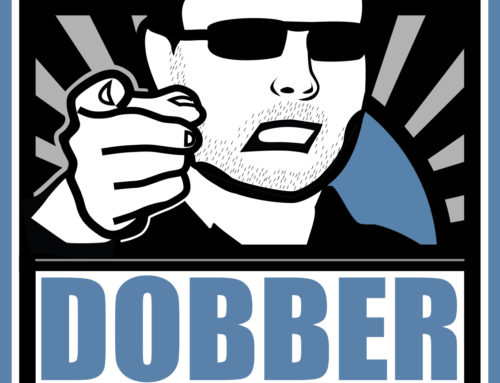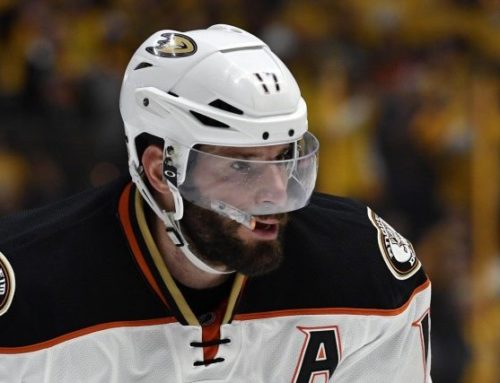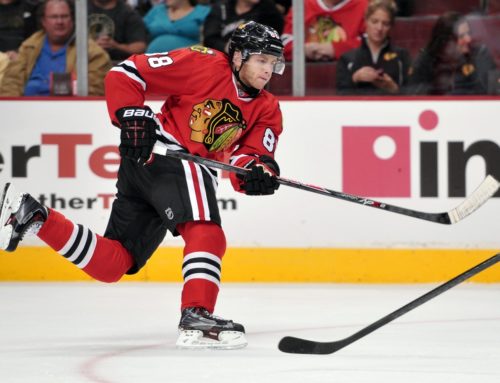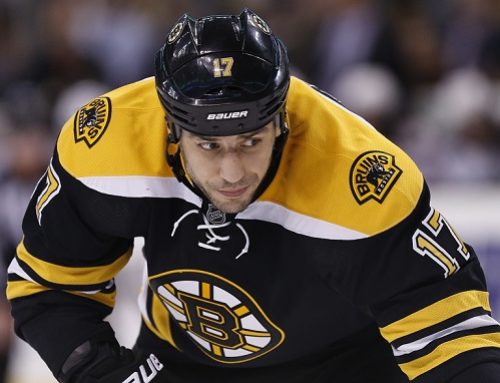April Mock
Dobber Sports
2010-04-03

(Tyler Seguin and Taylor Hall in OHL playoff action. Photo Credit: Windsor Star)
The CHL playoffs are getting good with the top two prospects facing off head-to-head in the OHL semi-finals. How is the rest of the top thirty fairing?
1. Edmonton Oilers- LW Taylor Hall (Windsor OHL)
The good news: the Edmonton Oilers finally clinched something. The bad news: what they clinched was last place in the entire NHL. While that doesn’t assure them of the first overall pick, the Oilers now have the best odds of winning the 2010 Draft Lottery on April 13th and can pick no later than second.
The choice is and remains obvious. Windsor Spits star Taylor Hall has continued his torrid scoring pace into the playoffs, and leads the OHL in playoff goals with eight in just five games. Most casual observers will point to a talent disparity between Windsor and Plymouth as the reason Hall has twelve points in five games and Tyler Seguin has ten in six, but both teams are clicking at over 4.5 goals per game.
2. Boston Bruins (from Toronto)- C Tyler Seguin (Plymouth OHL)
Although just three points separate the Maple Leafs from the Tampa Bay Lightning and Florida Panthers in the fight for second-last, it’s a battle that’s likely over. Toronto had just four games left on their schedule to leap-frog the teams ahead of them, and can finish no better than 23rd even if they were to win all of their remaining contests and see every team above them lose.
As such, the Bruins can be reasonably assured that their pick will be a very good one. A team formerly quite blessed at center, Marc Savard’s potentially career-crippling concussion and Patrice Bergeron’s failure to step up in his absence means the team could use further depth at center. That rearguard Cam Fowler has played some of his worst hockey at the worst time also makes this an easier choice for the Bruins. Seguin lacks Hall’s grit and desire in traffic, but his skills are elite and he may prove to be the better point producer of the two at the next level.
3. Tampa Bay Lightning- D Cam Fowler (Windsor OHL)
Despite a fearsome one-two punch of Steve Stamkos and Victor Hedman plus upper-tier veterans Vincent Lecavalier and Martin St. Louis, as their current position indicates, the Tampa Lightning need a great many things at many positions. It may be another two years before the team seriously challenges for a playoff berth and this pick will simply be a drop in the bucket. If they remain in the 3rd spot- or, in the worst case, drop- there are numerous options. GM (for now) Brian Lawton has the option of supplementing his forward talent and getting back to the kind of offense that won the franchise their only Cup.
But building from the blueline out is the mantra of a great many championship teams, and there are two defenders worthy of consideration in the top five. Cam Fowler may seem to be hanging to a top three position on name alone, but as we always say, it’s more pertinent to examine a full season of work rather than a brief bad run. Fowler isn’t the biggest, fastest or most skilled rearguard available in the first round but he’s the only one who is above-average in almost every facet. A muffin pointshot is still a major worry and Fowler will never be more than a slick puck distributor until he solves that, but Sheldon Souray didn’t hone his until later. When that’s the most you have to worry about, you’re doing good.
4. Florida Panthers- C/RW Vladimir Tarasenko (Sibir KHL)
The Florida Panthers in a none-too-enviable position. On paper, their roster is a solid, young group capable of great things. On ice, the team is developing at a snail’s pace and there isn’t a single franchise talent in the group that can contend with the star power of visiting teams like Washington and Tampa Bay.
The best thing that could happen for the Panthers is for the team to win the draft lottery; it would buy the team another year and another name to sell to an impatient fanbase, and Taylor Hall’s speed and potential for highlight-reel goals has been missing since Pavel Bure’s departure.
That’s why Vladimir Tarasenko is the best pick at forward. A gifted puckhandler that we rate the best in the class, Tarasenko doesn’t possess explosive speed but he’s electrifying with the puck on his stick and quietly dominant away from it. There’s absolutely the risk Tarasenko doesn’t jump- he’s already committed to finishing his two-year deal with Sibir- but he’s not an immediate NHLer anyway and could use the development time. When he’s ready he’ll be something else.
5. New York Islanders- D Erik Gudbranson (Kingston OHL)
Seven points separated the Kingston Frontenacs and Brampton Battalion in the OHL regular season standings, so it’s fitting that the teams needed seven games to decide the winner. Defender Erik Gudbranson continued to correct his stock following a season-long bout with mono. Despite finishing with just three points an even rating, the 6’3, 201 lbs rearguard showed flashes of talent; he was a +3 in a wild 7-4 victory, and netted the game-winner on March 28th to force the decisive seventh game.
Still, there were some rough spots and it’s exactly that inconsistency that makes him a question mark over a season-proven player like Fowler or Brandon Gormley. That he’s not faster or leaps and bounds bigger than either simply pushes him further back. Still, the Islanders have developed a reputation for reaching for the players that embody the organization’s most coveted traits no matter the package and it’s a similar formula that allowed the Wings to become a dynasty.
6. Carolina Hurricanes- D Brandon Gormley (Moncton QMJHL)
Pending a complete collapse down the stretch and/or a lottery win, the Carolina Hurricanes are no longer in the running for Tyler Seguin. That’s a shame in more ways than one; despite him being the closest thing to home-bred available in the first round, the Canes need more forward depth and the top ten contains more questions than bluechips at this point.
The safe pick would be a defender, the Canes are big on the safe pick. While 6’2 Brandon Gormley plays a very similar game to many of the organization’s most-coveted defensemen- see big, slick but not physical- Carolina didn’t boast any big bruisers when they won their first and only Stanley Cup in 2007. Instead, the team has always relied on a safe, reliable transition game and that starts with speed and reach on the defense.
Moncton got exactly that from Brandon Gormley during the first round of the QMJHL playoffs. While he didn’t register a goal, Gormley had a pair of two-assist games and finished a +6 as the Wildcats potted twenty goals in just five games.
7. Columbus Blue Jackets- C Alexander Burmistrov (Barrie OHL)
There are players who have solid regular seasons and great playoffs. Then there are the players who simply play at a completely different level with games on the line. Rick Nash is one such player; although he hasn’t seen many critical games in a Columbus uniform, the robust winger has 21 goals in 27 career World Championship games.
Then there’s Alexander Burmistrov. After a respectable rookie season in the OHL in which the Russian center potted 65 points in 62 games, Burmistrov and the OHL-leading Colts met the blue-collar Sudbury Wolves in the first round. All that stuff about hard work beating talent? Not when a player of Burmistrov’s talent is a hard worker. Burmistrov picked up four points in Game 1 and had five more by the time the series was over three games later.
Fourth in the OHL in playoff goals and a point ahead of Tyler Seguin, Burmistrov has smashed all preconceptions about Russians in the OHL. He’s a worthy top eight seven pick and could go even higher in June if Barrie can continue their play into the Mem Cup.
8. Atlanta Thrashers- LW Brett Connolly (Prince George WHL)
Replacing a player of Ilya Kovalchuk’s ability is never easy, but it becomes almost impossible when you pick towards the end of the top ten rather than the beginning. Even without him, the Thrashers are almost back to playoff relevance; abrugeoning core of Evander Kane, Bryan Little, Zach Bogosian and Ondrej Pavelec is a strong starting point and the addition of mercurial talent Nicklas Bergfors has proven to be a boon.
Still, the team could use a dynamic scorer that boasts plenty of speed and one-on-one ability- not only for depth’s sake, but marketing too. That’s where Brett Connolly comes in. After a slow start to his comeback, Connolly finished strong with three goals and six points in four games. Connolly is a major risk but Atlanta has the cap space and prospect depth to compensate if his injury issues prove too much to overcome. If he pans out, he could be a monumental steal.
9. Minnesota Wild- RW Austin Watson (Peterborough OHL)
The problem with hot streaks is that there’s always the risk they stop and never re-appear. Consider the case of Austin Watson; his OHL career revived by a trade deadline move to the Peterborough Petes, Watson’s 20 points in ten games drove the team to a playoff spot and his draft stock to unseen heights.
However, by the time the OHL quarterfinals started, Watson’s chariot turned back into a pumpkin. The Michigan product was held to just two goals in a four game sweep at the hands of the Mississauga St. Michael’s Majors, finishing the series a -4.
Watson is still a good bet to go in the top fifteen because of his mix of size, soft hands and strong boardplay. But any team that takes him will have to live with a long and likely painful development period as the 6’3 forward grows into his rapidly strengthening body. That’s no problem for the Wild; although they’ve changed head coaches and presumably their organizational philosophy, the team likely didn’t involve head coach Jacques Lemaire in every draft choice and the team still took big North American kids with skill and speed at every opportunity. Watson is as boom-bust as it gets and while the Wild have had mild successlike Brent Burns and Colton Gillies, they’ve also seen
10. New York Rangers- LW Nino Niederreiter (Portland WHL)
One day, Glen Sather will learn to build a team that’s strong down the middle rather than reliant on scoring from its wings. Chris Drury as a #1 center was a good idea maybe seven years ago, but not today. Marian Gaborik is the team’s only game-breaker and even if Henrik Lundqvist had managed to drag the Rags to the post-season Ryan Miller style, they’d likely have been swept or close to it.
However, if Sather keeps his job into the Draft, can he resist a 6’2 winger who has shown a penchant for scoring goals from anywhere on the ice? The biggest test remaining for the Swiss native was the WHL playoffs; even a slight decline in play would have brought detractors out of the woodwork. As it is, Niederreiter is the only rookie top ten point-getter in the WHL and will have ample opportunity to add to those numbers following a thrilling 5-4 OT victory over the Spokane Chiefs in Game 7 of the quarterfinals. Although not a game star, Niederreiter potted a goal and an assist to help the Winterhawks rally from a 3-0 deficit midway through the second.
11. Anaheim Ducks (from Philadelphia)- LW Kirill Kabanov (Nobody)
Russians and the Anaheim Ducks have a long and none-too-fruitful history. While the sun and fun of the West Coast and the ability to remain both anonymous and rich is a plus to players from almost every country, it’s proven too much for talents like Stanislav Chistov, Alexei Smirnov and Sergei Fedorov. But the Ducks are desperate to return to playoff contention; with long-term projects on defense abound, it may suit Anaheim best to invest in one of the most most physical and most skilled talents in the Draft.
It’s somewhat ironic that the Ducks are in position to take a game-changing power forward that doesn’t need work on his skating, only to have that talent be potentially as good a fit as oil and water. Still, Anaheim invested in a Russian with a 3rd round pick or higher as recently as last year (Igor Bobkov). It’s not entirely out of the realm of possibility.
However, even the Ducks won’t touch Kabanov if the Russian enigma fails to have anything less than a great U18s. For a player that’s missed almost the entire year, he has no excuse to be anything but rested, fresh and dominant.
12. Boston Bruins- D Derek Forbort (USNTDP U18)
Derek Forbort did not have a strong finish to the NTDP’s USHL season, but that may not preclude a team from selecting him ahead of teammate Jon Merrill. While neither was a world-beater, Forbort’s only two points in March came in the team’s final game, a 10-2 romp over Indiana. In total he was 0-2-2 with an even rating- recovering from a -3 game in a 4-1 loss earlier in the month.
While Forbort was not surprisingly given an invite to the Draft Combine, teams already know what his 6’4, 195 lbs frame can provide. What’s far more criticial is Team USA’s next stop- and the UND commit’s last chance to unequivocally prove he belongs in the top half of the first round- is the IIHF World U18s in Belarus starting April 13th.
For the Bruins, two top fifteen picks gives them the room to gamble. The Oilers did a similar thing in 2007, using their top ten pick on a slick center (Sam Gagner) and their mid-1st on a big rearguard with untapped potential (Alex Plante). While the Bs could ideally use a low-event player that can crack the roster in one to two years’ time, there are likely only two defenders in 2010 that can make the jump immediately. Still, Forbort has the talent to be the kind of All-Star talent Boston has seemingly had every decade on their blueline.
13. St. Louis Blues- C/RW Mikael Granlund (HIFK Helsinki)
The St. Louis Blues find themselves in a none-too-enviable position if Russia mega-talent Kirill Kabanov falls to their pick in the mid-teens. While an organization that prides themselves on filling every available job with hard-working, character people, the Blues have so far failed to fill the ever-widening hole at left wing either in-house or via free agency. Goal scoring across the entire roster is down as mercurial talents like Brad Boyes have failed to string together more than a couple of good weeks.
So, is the best solution to take a moody Russian forward who can be just as streaky or invisible as the team’s worst offenders? It’s a tough choice and it’s one the Blues may have to take. Hopefully, they have the opportunity to snap up a player just as skilled but who plays the game with passion and responsibility every period and not just whenever he feels like it.
Enough about his ‘sub-par’ World Juniors; Mikael Granlund ended the SM-Liiga season strong, finishing a point shy of that league’s record for points by a U18 player (Olli Jokinen- 41 points). In three playoff games, he has four points- all assists- and has been every bit as lethal as advertised.
Granlund is a top-notch talent; a team serious about acquiring talent in any form will not hesitate to select him anywhere after the top two and while Dallas is currently deep both at center and up front in general, a team can never have enough game-breakers.
14. Anaheim Ducks- D Mark Pysyk (Edmonton WHL)
The Anaheim Ducks did a great deal of tinkering prior to the NHL trade deadline. By acquiring Lubomir Visnovsky, the Ducks replaced Scott Niedermayer’s transition game and powerplay ability whenever he decides to retire again. The team also killed their two-headed monster in net by handing the reigns over to the younger, better and less expensive of the two. They also added a pair of veteran reclamation projects in Jason Blake and Aaron Ward, with mixed results.
But none of it has been the spark the team was looking for to contend in the deep Western Conference. The Ducks will still enter the summer with five regular defenders entering or unrestriced or restricted free agency, and no bluechip youngsters to replace them.
As we’ve mentioned numerous times, Pysyk has shown the ability to be a big-minute workhorse capable of shutting down opposing players with his size, speed and hockey sense. While his major weaknesses at this point are strength and endurance, he won’t have to worry about playing 35+ minutes a night immediately with whatever NHL team picks him in June.
15. Dallas Stars- G Jack Campbell (USNTDP U18)
Arguably the catalyst of one of the biggest upsets in WJC history, Michigan native Jack Campbell finished the USHL portion of the NTDP schedule with a 6-3-1 record, a 2.21 GAA and a 0.917 save percentage.
However, what truly sets him apart from almost every other goaltender selected in the last few years as an 18-year-old is hardware. In five games at last year’s U18, Campbell allowed under a goal per game and boasted a 0.967 save percentage as the Americans romped to Gold. As a 16-year-old Campbell and the NTDP also qualified for the World Under-17 Hockey Challenge where he and Team USA won Bronze.
Campbell is a winner through-and-through; as pointed out last month, for a team that’s had no problem finding adequate regular season goaltending only to have their keeper implode in the playoffs, Campbell is the absolute perfect choice for the Stars both short and long-term.
16. Montreal Canadiens- C Riley Sheahan (Notre Dame NCAA)
Power pivot Riley Sheahan did not have the kind of playoffs he likely needed to drive his stock much higher than mid-first. In two CCHA Tournament games, Sheahan was held pointless and Notre Dame managed only four goals and zero wins.
Still, Sheahan is the kind of player the Habs constantly fall over themselves to draft- a stocky American high school or college product who possesses both tremendous skill and character. That he’s already shown the ability to dominate 22-year-olds (albeit in short stretches) is bound to further draw saliva from Canadiens head scout Trevor Timmins. A December-born ’91, Sheahan also has the added advantage of being able to jump to the AHL in one season if he earns the opportunity in 2010-11.
17. Phoenix Coyotes (via Calgary)- C Ryan Johansen (Portland WHL)
While unbridled speed and skill were leaned on early in Wayne Gretzky’s tenure as the organizational philosophy of the Phoenix Coyotes, Dave Tippett’s arrival saw the implementation of systems hockey. Contrary to popular belief, it’s led to some of the most exciting hockey the city has ever seen and subsequently their highest finish.
If Tippett has a big say in what the team does at the Draft- and after a Jack Adams-worthy season, it’s a good bet he will- the top of wishlist will likely feature a big center capable of gaining the zone and winning draws.
That’s Ryan Johansen’s game in a nutshell. As perfect a fit for a puck possession system as exists, Johansen’s pro approach to the game has been a boon to the Winterhawks. In six games, the 6’3 center has six assists and nine points on line with Nino Niederreiter and Brad Ross.
If Johansen can improve his speed, he has the polished all-around game to be a steal on the level of Mike Richards.
18. Colorado Avalanche- D Dylan McIlrath (Moose Jaw WHL)
While Colorado’s Cinderella run on the backs of their young core is quickly fading as the intensity gets higher, some things have become clear. For one, the team has ample amounts of skill and two-way play in their forward ranks to last the next decade. Secondly, goaltending and defense are still concerns.
With Jack Campbell likely long-gone by this point, the Avs would do best to continue to shore up the defense. While they already have a pipeline loaded with bluechip rearguards, most of them are cut from the same cloth: big, smooth-skating puck movers that rarely get their noses dirty. Ryan Wilson has been an eye-opener precisely because he is a rarity on the Avalanche blue.
While Dylan McIlrath wasn’t near as potent in the WHL playoffs offensively as a late-season emergence suggested he might be, he was every bit as sound defensively despite a -1 rating. But the 6’5, 215 lbs behemoth had another surprise in store. Above-average all year in terms of footspeed and acceleration as he defended his crease, McIlrath was forced to skate greater distances as the Calgary Hitmen challenged him one-on-one with their tremendous team speed. Utilizing a longer stride, taking shorter shifts and flat-out busting his balls, McIlrath not only kept up with the likes of Brandon Kozun but out-skated him at times to loose pucks.
McIlrath is proof that development can happen at any time- even during the playoffs. With a better statline than Tyler Myers at the same age, he’ll prove an interesting commodity in the first round.
19. Ottawa Senators- C Jeff Skinner (Kitchener OHL)
The argument against Jeff Skinner all year has been wait and see: Wait and see if he can maintain his 50-goal pace; wait and see if he fades down the stretch. Finally, it was wait and see how he performed in the playoffs.
We now have an answer. The 5’10, 197 lbs center was both at his best (scoring) and worst (defensively) at times against Saginaw in the OHL quarterfinals. While he finished with a 3-2-5 line in a six-game triumph, Skinner nevertheless finished a -1.
However, Skinner’s taken his game to a new level against London. Forced to not only score but keep Knights superstar Nazem Kadri in check, Skinner has four points in two games and is a +3 as Kitchener is tied with London at one game a piece.
Wihile the Senators have finally returned to post-season relevance, they can’t rely on Jason Spezza to score at a 50-goal pace every season. The Sens need a top-end scorer and Skinner- for all his weaknesses at this point- could be the answer.
20. Los Angeles Kings- RW Beau Bennett (Penticton BCHL)
It’s getting to be the worst-kept secret in the NHL. Tier II junior star Beau Bennett has quickly become the enigma of the first round; although the BCHL’s most dominant 18-year-old during the regular season since Kyle Turris, Bennett and the #2 Penticton Vees were handed a six-game loss by the top-seeded Vernon Vipers enroute to an exit in the Interior Conference Finals.
Nevertheless, Bennett still managed to click along at a point-per-game pace with fourteen points in fifteen games. Ineligible for the U18s, his next big stage will be the NHL Combine. A strong showing amongst his peers would have been icing on the cake, but then it might have also pushed his stock out of range of his favorite team- the LA Kings. Don’t be surprised if Dean Lombardi calls his name- at all.





 CHI
CHI SEA
SEA FLA
FLA DAL
DAL WPG
WPG CBJ
CBJ L.A
L.A MIN
MIN DET
DET BOS
BOS
